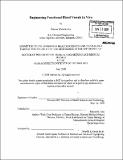Engineering functional blood vessels in vivo
Author(s)
Au, Pakwai
DownloadFull printable version (31.18Mb)
Other Contributors
Harvard University--MIT Division of Health Sciences and Technology.
Advisor
Rakesh K. Jain.
Terms of use
Metadata
Show full item recordAbstract
At the present time, there are many hurdles to overcome in order to create a long-lasting and engineered tissue for tissue transplant in patients. The challenges include the isolation and expansion of appropriate cells, the arrangement of assorted cells into correct spatial organization, and the development of proper growth conditions. Furthermore, the creation of a three dimensional engineered tissue is limited by the fact that tissue assemblies greater than 100-200 micrometers, the limit of oxygen diffusion, require a perfused vascular bed to supply nutrients and to remove waste products and metabolic intermediates. To overcome this limitation, this thesis aims to pre-seed a tissue engineered construct with vascular cells (both endothelial and perivascular cells), so the vascular cells could readily form functional vessels in situ. Previous work in the laboratory had successfully demonstrated the formation of functional microvascular network by co-implantation of human umbilical cord vein endothelial cells (HUVECs) and 10 T 1/2 cells, a line of mouse embryonic fibroblasts. To translate this concept to the clinic, we need to utilize cells that can be secured and used in clinic. To this end, we systematically replace each individual vascular cell type with a readily available source of cells. First, we investigated human embryonic stem cells (hESCs) derived endothelial cells. We demonstrated that when hESCs derived endothelial cells were implanted into SCID mice, they formed blood vessels that integrated into the host circulatory system and served as blood conduits. Second, we compared the formation and function of engineered blood vessels generated from circulating endothelial progenitor cells (EPCs) derived from either adult peripheral blood or umbilical cord blood. (cont.) We found that adult peripheral blood EPCs formed blood vessels that were unstable and regressed within three weeks. In contrast, umbilical cord blood EPCs formed normal-functioning blood vessels that lasted for more than four months. These vessels exhibited normal blood flow, perm-selectivity to macromolecules and induction of leukocyte-endothelial interactions in response to cytokine activation similar to normal vessels. Third, we evaluated human bone marrow-derived mesenchymal stem cells (hMSCs) as a source of vascular progenitor cells. hMSCs expressed a panel of smooth muscle markers in vitro and cell-cell contact between endothelial cells and hMSCs up-regulated the transcription of smooth muscle markers. hMSCs efficiently stabilized nascent blood vessels in vivo by functioning as perivascular precursor cells. The engineered blood vessels derived from HUVECs and hMSCs remained stable and functional for more than 130 days in vivo. On the other hand, we could not detect differentiation of hMSCs to endothelial cell in vitro and hMSCs by themselves could not form conduit for blood flow in vivo. Similar to normal perivascular cells, hMSCs-derived perivascular cells contracted in response to endothelin-1 in vivo. Thus, our work demonstrates the potential to generate a patent and functional microvascular network by pre-seeding vascular cells in a tissue-engineered construct. It serves as a platform for the addition of parenchymal cells to create a functional and vascularized engineered tissue.
Description
Thesis (Ph. D.)--Harvard-MIT Division of Health Sciences and Technology, 2008. Includes bibliographical references.
Date issued
2008Department
Harvard University--MIT Division of Health Sciences and TechnologyPublisher
Massachusetts Institute of Technology
Keywords
Harvard University--MIT Division of Health Sciences and Technology.